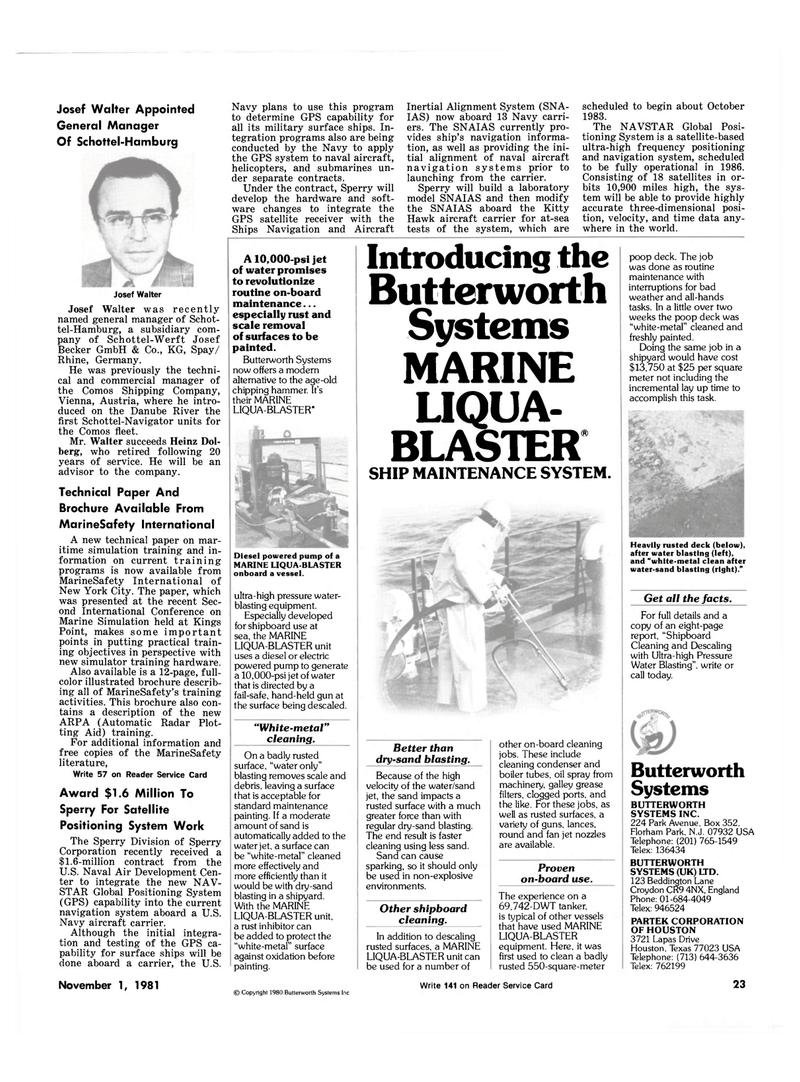
Page 25: of Maritime Reporter Magazine (November 1981)
Read this page in Pdf, Flash or Html5 edition of November 1981 Maritime Reporter Magazine
Josef Walter Appointed
General Manager
Of Schottel-Hamburg
Josef Walter
Josef Walter was recently named general manager of Schot- tel-Hamburg, a subsidiary com- pany of Schottel-Werft Josef
Becker GmbH & Co., KG, Spay/
Rhine, Germany.
He was previously the techni- cal and commercial manager of the Comos Shipping Company,
Vienna, Austria, where he intro- duced on the Danube River the first Schottel-Navigator units for the Comos fleet.
Mr. Walter succeeds Heinz Dol- berg, who retired following 20 years of service. He will be an advisor to the company.
Technical Paper And
Brochure Available From
MarineSafety International
A new technical paper on mar- itime simulation training and in- formation on current training programs is now available from
MarineSafety International of
New York City. The paper, which was presented at the recent Sec- ond International Conference on
Marine Simulation held at Kings
Point, makes some important points in putting practical train- ing objectives in perspective with new simulator training hardware.
Also available is a 12-page, full- color illustrated brochure describ- ing all of MarineSafety's training activities. This brochure also con- tains a description of the new
ARPA (Automatic Radar Plot- ting Aid) training.
For additional information and free copies of the MarineSafety literature,
Write 57 on Reader Service Card
Award $1.6 Million To
Sperry For Satellite
Positioning System Work
The Sperry Division of Sperry
Corporation recently received a $1.6-million contract from the
U.S. Naval Air Development Cen- ter to integrate the new NAV-
STAR Global Positioning System (GPS) capability into the current navigation system aboard a U.S.
Navy aircraft carrier.
Although the initial integra- tion and testing of the GPS ca- pability for surface ships will be clone aboard a carrier, the U.S.
Navy plans to use this program to determine GPS capability for all its military surface ships. In- tegration programs also are being conducted by the Navy to apply the GPS system to naval aircraft, helicopters, and submarines un- der separate contracts.
Under the contract, Sperry will develop the hardware and soft- ware changes to integrate the
GPS satellite receiver with the
Ships Navigation and Aircraft
A 10,000-psi jet of water promises to revolutionize routine on-board maintenance... especially rust and scale removal of surfaces to be painted.
Butterworth Systems now offers a modern alternative to the age-old chipping hammer. It's their MARINE
LIQUA-BLASTER*
Diesel powered pump of a
MARINE LIQUA-BLASTER onboard a vessel. ultra-high pressure water- blasting equipment.
Especially developed for shipboard use at sea, the MARINE
LIQUA-BLASTER unit uses a diesel or electric powered pump to generate a 10,000-psi jet of water that is directed by a fail-safe, hand-held gun at the surface being descaled. "White-metal" cleaning.
On a badly rusted surface, "water only" blasting removes scale and debris, leaving a surface that is acceptable for standard maintenance painting. If a moderate amount of sand is automatically added to the water jet, a surface can be "white-metal" cleaned more effectively and more efficiently than it would be with dry-sand blasting in a shipyard.
With the MARINE
LIQUA-BLASTER unit, a rust inhibitor can be added to protect the "white-metal" surface against oxidation before painting.
Inertial Alignment System (SNA-
IAS) now aboard 13 Navy carri- ers. The SNAIAS currently pro- vides ship's navigation informa- tion, as well as providing the ini- tial alignment of naval aircraft navigation systems prior to launching from the carrier.
Sperry will build a laboratory model SNAIAS and then modify the SNAIAS aboard the Kitty
Hawk aircraft carrier for at-sea tests of the system, which are scheduled to begin about October 1983.
The NAVSTAR Global Posi- tioning System is a satellite-based ultra-high frequency positioning and navigation system, scheduled to be fully operational in 1986.
Consisting of 18 satellites in or- bits 10,900 miles high, the sys- tem will be able to provide highly accurate three-dimensional posi- tion, velocity, and time data any- where in the world. poop deck. The job was done as routine maintenance with interruptions for bad weather and all-hands tasks. In a little over two weeks the poop deck was "white-metal" cleaned and freshly painted.
Doing the same job in a shipyard would have cost $13,750 at $25 per square meter not including the incremental lay up time to accomplish this task.
Heavily rusted deck (below), after water blasting (left), and "white-metal clean after water-sand blasting (right)."
Get all the facts.
For full details and a copy of an eight-page report, "Shipboard
Cleaning and Descaling with Ultra-high Pressure
Water Blasting", write or call today.
Butterworth
Systems
BUTTERWORTH
SYSTEMS INC. 224 Park Avenue, Box 352,
Florham Park. N.J. 07932 USA
Telephone: (201) 765-1549
Telex: 136434
BUTTERWORTH
SYSTEMS (UK) LTD. 123 Beddington Lane
Croydon CR9 4NX, England
Phone: 01-684-4049
Telex: 946524
PARTEK CORPORATION
OF HOUSTON 3721 Lapas Drive
Houston. Texas 77023 USA
Telephone: (713) 644-3636
Telex: 762199
Introducing the Butterworth
Systems
MARINE
LIQUA-
BLASTER"
SHIP MAINTENANCE SYSTEM.
Better than dry-sand blasting.
Because of the high velocity of the water/sand jet, the sand impacts a rusted surface with a much greater force than with regular dry-sand blasting.
The end result is faster cleaning using less sand.
Sand can cause sparking, so it should only be used in non-explosive environments.
Other shipboard cleaning.
In addition to descaling rusted surfaces, a MARINE
LIQUA-BLASTER unit can be used for a number of other on-board cleaning jobs. These include cleaning condenser and boiler tubes, oil spray from machinery, galley grease filters, clogged ports, and the like. For these jobs, as well as rusted surfaces, a variety of guns, lances, round and fan jet nozzles are available.
Proven on-board use.
The experience on a 69,742-DWT tanker, is typical of other vessels that have used MARINE
LIQUA-BLASTER equipment. Here, it was first used to clean a badly rusted 550-square-meter
November 1, 1981 © Copyright 1980 Butterworth Systems Inc
Write 1411 on Reader Service Card 23

 24
24

 26
26
